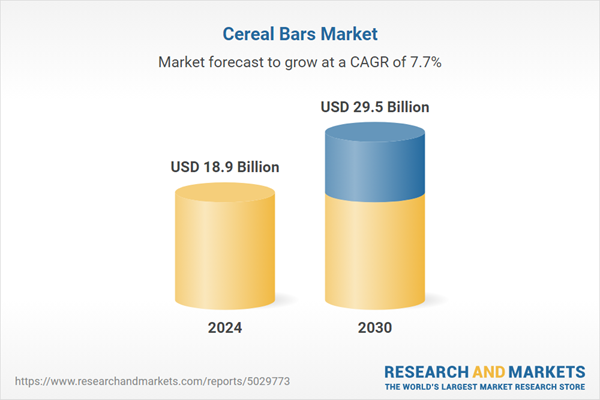The global market for Cereal Bars was valued at US$18.9 Billion in 2024 and is projected to reach US$29.5 Billion by 2030, growing at a CAGR of 7.7% from 2024 to 2030. This comprehensive report provides an in-depth analysis of market trends, drivers, and forecasts, helping you make informed business decisions. The report includes the most recent global tariff developments and how they impact the Cereal Bars market.
Segments: Product Type (Snack Bars, Nutrition Bar, Other Product Types).
Geographic Regions/Countries: World; United States; Canada; Japan; China; Europe (France; Germany; Italy; United Kingdom; Spain; Russia; and Rest of Europe); Asia-Pacific (Australia; India; South Korea; and Rest of Asia-Pacific); Latin America (Argentina; Brazil; Mexico; and Rest of Latin America); Middle East (Iran; Israel; Saudi Arabia; United Arab Emirates; and Rest of Middle East); and Africa.
The analysts continuously track trade developments worldwide, drawing insights from leading global economists and over 200 industry and policy institutions, including think tanks, trade organizations, and national economic advisory bodies. This intelligence is integrated into forecasting models to provide timely, data-driven analysis of emerging risks and opportunities.
Global Cereal Bars Market - Key Trends and Drivers Summarized
Why Are Cereal Bars Dominating The Healthy Snack Market?
Cereal bars have surged in popularity, establishing themselves as a go-to option for health-conscious consumers looking for convenient and nutritious snacks. This rise can be attributed to the growing consumer shift toward healthier eating habits, coupled with a desire for quick, portable food solutions that fit into increasingly busy lifestyles. Once viewed simply as an alternative to traditional sugary snacks, cereal bars have undergone a significant transformation, offering an array of formulations that go beyond the basic combination of grains and sweeteners. Modern cereal bars now incorporate a wide range of ingredients such as whole grains, nuts, seeds, and dried fruits, while also incorporating protein-rich elements like yogurt or whey to appeal to fitness enthusiasts and those seeking balanced nutrition. The versatility of cereal bars makes them an appealing option for different consumer segments - athletes, working professionals, and parents alike - who are looking for energy-boosting snacks that can be consumed on the go. Their portability, combined with their ability to offer nutritional benefits in a single serving, has solidified their place in the crowded snack market.How Is Innovation Shaping The Future Of Cereal Bars?
The cereal bar industry has not only kept pace with changing consumer demands but has also pushed the boundaries of innovation to offer a wider range of products that meet specific dietary needs and preferences. A significant trend in recent years has been the introduction of cereal bars catering to consumers following specialized diets, such as gluten-free, vegan, keto, and paleo. As awareness of food intolerances and dietary restrictions grows, so does the need for products that are both accessible and nutritious, making these specialty bars a key area of growth. Advances in food processing technology have enabled manufacturers to improve the texture, taste, and nutritional profile of cereal bars without relying on artificial additives, ensuring that even high-protein or low-sugar bars maintain the flavor and quality consumers expect. Additionally, many brands are incorporating superfoods like chia seeds, flaxseeds, and quinoa, tapping into the growing trend of nutrient-dense, functional foods. Packaging innovation is also playing a crucial role, with companies increasingly shifting to eco-friendly materials in response to rising consumer demand for sustainable and ethically produced products. This combination of ingredient innovation and sustainable packaging positions cereal bars as a forward-thinking category within the broader snack market.What Role Do Changing Consumer Preferences Play?
Consumer preferences have evolved dramatically, and these changes have had a profound impact on the cereal bar market. One of the most notable trends is the growing demand for transparency and clean-label products, with more consumers prioritizing snacks made from simple, natural ingredients over those containing artificial preservatives, colors, and additives. This shift is part of a broader clean-eating movement, where consumers are choosing whole and minimally processed foods that contribute to overall health and well-being. As consumers become more health-conscious, they are increasingly aware of the nutritional content of their snacks, seeking out bars that are high in protein, fiber, and healthy fats, while avoiding those loaded with sugars and empty calories. Plant-based nutrition is another growing trend, leading to the rise of cereal bars that feature plant-derived proteins such as pea, hemp, and soy, catering to the expanding vegan and vegetarian consumer base. Moreover, consumers are placing greater emphasis on the ethical and environmental footprint of the products they purchase. Brands that use sustainably sourced ingredients or support fair trade practices are gaining favor with environmentally aware buyers, further driving growth in this sector. The combination of these evolving preferences has created a fertile landscape for cereal bar manufacturers to innovate and diversify their offerings.What Are The Key Factors Driving Growth In The Cereal Bars Market?
The growth in the cereal bars market is driven by several factors that are shaping both consumer behavior and industry trends. A primary driver is the increasing consumer focus on health and wellness, with many people actively seeking snacks that provide nutritional benefits, such as high fiber or protein content, while maintaining low sugar levels. As the global population becomes more health-conscious, there is a growing demand for functional foods that not only satisfy hunger but also contribute to overall well-being, making cereal bars a convenient solution. The fast-paced, on-the-go lifestyle prevalent among millennials, Gen Z, and working professionals has further boosted demand for easily accessible, portable snacks that can be consumed without preparation. Additionally, advancements in food processing technologies have enabled manufacturers to improve the nutritional profile and taste of cereal bars, allowing them to cater to diverse dietary needs, including gluten-free, low-carb, and plant-based diets. Moreover, the rising interest in environmental sustainability is influencing purchasing decisions, with consumers showing a preference for cereal bars made from ethically sourced ingredients and packaged in eco-friendly materials. E-commerce and direct-to-consumer channels have also played a critical role in expanding market reach, making it easier for niche and premium brands to connect with health-conscious consumers looking for high-quality, innovative products. These factors collectively are driving robust growth in the cereal bars market.Report Scope
The report analyzes the Cereal Bars market, presented in terms of units. The analysis covers the key segments and geographic regions outlined below.Segments: Product Type (Snack Bars, Nutrition Bar, Other Product Types).
Geographic Regions/Countries: World; United States; Canada; Japan; China; Europe (France; Germany; Italy; United Kingdom; Spain; Russia; and Rest of Europe); Asia-Pacific (Australia; India; South Korea; and Rest of Asia-Pacific); Latin America (Argentina; Brazil; Mexico; and Rest of Latin America); Middle East (Iran; Israel; Saudi Arabia; United Arab Emirates; and Rest of Middle East); and Africa.
Key Insights:
- Market Growth: Understand the significant growth trajectory of the Snack Bars segment, which is expected to reach US$20.7 Billion by 2030 with a CAGR of a 7.6%. The Nutrition Bar segment is also set to grow at 8.6% CAGR over the analysis period.
- Regional Analysis: Gain insights into the U.S. market, valued at $4.9 Billion in 2024, and China, forecasted to grow at an impressive 11.4% CAGR to reach $7.3 Billion by 2030. Discover growth trends in other key regions, including Japan, Canada, Germany, and the Asia-Pacific.
Why You Should Buy This Report:
- Detailed Market Analysis: Access a thorough analysis of the Global Cereal Bars Market, covering all major geographic regions and market segments.
- Competitive Insights: Get an overview of the competitive landscape, including the market presence of major players across different geographies.
- Future Trends and Drivers: Understand the key trends and drivers shaping the future of the Global Cereal Bars Market.
- Actionable Insights: Benefit from actionable insights that can help you identify new revenue opportunities and make strategic business decisions.
Key Questions Answered:
- How is the Global Cereal Bars Market expected to evolve by 2030?
- What are the main drivers and restraints affecting the market?
- Which market segments will grow the most over the forecast period?
- How will market shares for different regions and segments change by 2030?
- Who are the leading players in the market, and what are their prospects?
Report Features:
- Comprehensive Market Data: Independent analysis of annual sales and market forecasts in US$ Million from 2024 to 2030.
- In-Depth Regional Analysis: Detailed insights into key markets, including the U.S., China, Japan, Canada, Europe, Asia-Pacific, Latin America, Middle East, and Africa.
- Company Profiles: Coverage of players such as Atkins Nutritionals, Inc., Clif Bar & Company, Freedom Foods, General Mills, Inc., H. & J. BRUGGEN KG and more.
- Complimentary Updates: Receive free report updates for one year to keep you informed of the latest market developments.
Some of the 41 companies featured in this Cereal Bars market report include:
- Atkins Nutritionals, Inc.
- Clif Bar & Company
- Freedom Foods
- General Mills, Inc.
- H. & J. BRUGGEN KG
- Hain Celestial Group
- Kashi Company
- Kellogg Company
- Mars Inc.
- McKee Foods Corporation
- Naturell India Private Limited
- Nestle SA
Tariff Impact Analysis: Key Insights for 2025
Global tariff negotiations across 180+ countries are reshaping supply chains, costs, and competitiveness. This report reflects the latest developments as of April 2025 and incorporates forward-looking insights into the market outlook.The analysts continuously track trade developments worldwide, drawing insights from leading global economists and over 200 industry and policy institutions, including think tanks, trade organizations, and national economic advisory bodies. This intelligence is integrated into forecasting models to provide timely, data-driven analysis of emerging risks and opportunities.
What’s Included in This Edition:
- Tariff-adjusted market forecasts by region and segment
- Analysis of cost and supply chain implications by sourcing and trade exposure
- Strategic insights into geographic shifts
Buyers receive a free July 2025 update with:
- Finalized tariff impacts and new trade agreement effects
- Updated projections reflecting global sourcing and cost shifts
- Expanded country-specific coverage across the industry
Table of Contents
I. METHODOLOGYII. EXECUTIVE SUMMARY2. FOCUS ON SELECT PLAYERSIII. MARKET ANALYSISIV. COMPETITION
1. MARKET OVERVIEW
3. MARKET TRENDS & DRIVERS
4. GLOBAL MARKET PERSPECTIVE
UNITED STATES
CANADA
JAPAN
CHINA
EUROPE
FRANCE
GERMANY
ITALY
UNITED KINGDOM
SPAIN
RUSSIA
REST OF EUROPE
ASIA-PACIFIC
AUSTRALIA
INDIA
SOUTH KOREA
REST OF ASIA-PACIFIC
LATIN AMERICA
ARGENTINA
BRAZIL
MEXICO
REST OF LATIN AMERICA
MIDDLE EAST
IRAN
ISRAEL
SAUDI ARABIA
UNITED ARAB EMIRATES
REST OF MIDDLE EAST
AFRICA
Companies Mentioned (Partial List)
A selection of companies mentioned in this report includes, but is not limited to:
- Atkins Nutritionals, Inc.
- Clif Bar & Company
- Freedom Foods
- General Mills, Inc.
- H. & J. BRUGGEN KG
- Hain Celestial Group
- Kashi Company
- Kellogg Company
- Mars Inc.
- McKee Foods Corporation
- Naturell India Private Limited
- Nestle SA
Table Information
| Report Attribute | Details |
|---|---|
| No. of Pages | 323 |
| Published | April 2025 |
| Forecast Period | 2024 - 2030 |
| Estimated Market Value ( USD | $ 18.9 Billion |
| Forecasted Market Value ( USD | $ 29.5 Billion |
| Compound Annual Growth Rate | 7.7% |
| Regions Covered | Global |









